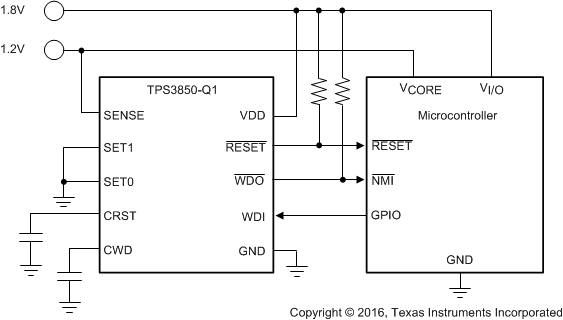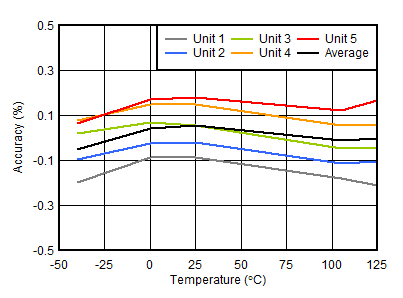ZHCSFY8B January 2017 – September 2021 TPS3850-Q1
PRODUCTION DATA
- 1 特性
- 2 应用
- 3 说明
- 4 Revision History
- 5 Pin Configuration and Functions
- 6 Specifications
- 7 Detailed Description
- 8 Application and Implementation
- 9 Power Supply Recommendations
- 10Layout
- 11Device and Documentation Support
- 12Mechanical, Packaging, and Orderable Information
3 说明
TPS3850-Q1 将可编程窗口看门狗定时器与高精度电压监控器相结合。TPS3850-Q1 窗口比较器在 SENSE 引脚上可针对过压 (VIT+(OV)) 和欠压 (VIT–(UV)) 阈值实现 0.8% 的精度(–40°C 至 +125°C)。TPS3850-Q1 在两种阈值条件下还可提供高精度迟滞,因此非常适用于容差要求严苛的系统。该监控器的 RESET 延迟可通过经出厂编程的默认延迟设置进行设定,也可以通过外部电容以编程方式设定。出厂编程的 RESET 延迟具备 9.5% 精度、高精度延迟时间。
TPS3850-Q1 具备适用于多种应用的可编程窗口看门狗计时器。专用看门狗输出 (WDO) 有助于提高分辨率,从而帮助确定出现故障情况的根本原因。窗口看门狗超时可通过经出厂编程的默认延迟设置进行设定,也可以通过外部电容以编程方式设定。可通过逻辑引脚禁用看门狗,避免在开发过程中出现意外的看门狗超时。
TPS3850-Q1 采用小型 3.00mm ×
3.00mm、10 引脚 VSON 封装。TPS3850-Q1 具有可湿性侧面,可轻松进行光学检查。
器件信息
| 器件型号 | 封装 (1) | 封装尺寸(标称值) |
|---|---|---|
| TPS3850-Q1 | VSON (10) | 3.00mm × 3.00mm |
(1) 如需了解所有可用封装,请参阅数据表末尾的可订购产品附录。
 典型应用电路
典型应用电路 过压阈值 (VIT+(OV)) 精度与温度间的关系
过压阈值 (VIT+(OV)) 精度与温度间的关系